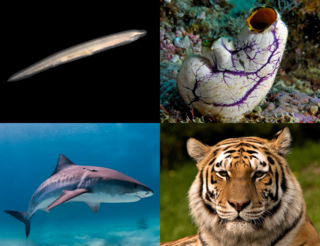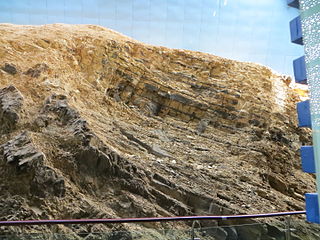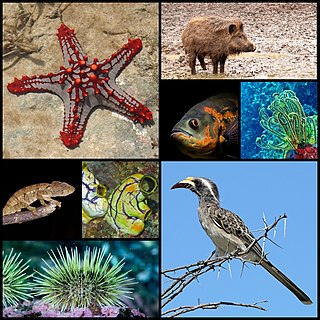
A chordate is a deuterostomic animal belonging to the phylum Chordata. All chordates possess, at some point during their larval or adult stages, five distinctive physical characteristics (synapomorphies) that distinguish them from other taxa. These five synapomorphies are a notochord, a hollow dorsal nerve cord, an endostyle or thyroid, pharyngeal slits, and a post-anal tail. The name "chordate" comes from the first of these synapomorphies, the notochord, which plays a significant role in chordate body plan structuring and movements. Chordates are also bilaterally symmetric, have a coelom, possess a closed circulatory system, and exhibit metameric segmentation.

The Cambrian is the first geological period of the Paleozoic Era, and the Phanerozoic Eon. The Cambrian lasted 53.4 million years from the end of the preceding Ediacaran period 538.8 Ma to the beginning of the Ordovician Period 485.4 Ma.

The Maotianshan Shales (帽天山页岩) are a series of Early Cambrian sedimentary deposits in the Chiungchussu Formation, famous for their Konservat Lagerstätten, deposits known for the exceptional preservation of fossilized organisms or traces. The Maotianshan Shales form one of some forty Cambrian fossil locations worldwide exhibiting exquisite preservation of rarely preserved, non-mineralized soft tissue, comparable to the fossils of the Burgess Shale of British Columbia, Canada. They take their name from Maotianshan Hill in Chengjiang County, Yunnan Province, China.

Haikouichthys is an extinct genus of craniate that lived 518 million years ago, during the Cambrian explosion of multicellular life. The type species, Haikouichthys ercaicunensis, was first described in 1999. Haikouichthys had a defined skull and other characteristics that have led paleontologists to label it a true craniate, and even to be popularly characterized as one of the earliest fishes. More than 500 specimens were referred to this taxon and phylogenetic analyses indicates that the animal is probably a basal stem-craniate. Some researchers have considered Haikouichthys to be synonymous with the other primitive chordate Myllokunmingia, but subsequent studies led by the British paleontologist Simon Conway Morris identified both genera to be distinct, separate taxa on the basis of different gill arrangement, the absence of branchial rays in Myllokunmingia and the myomeres having a more acute shape in Haikouichthys.

Cathaymyrus is a genus of Early Cambrian chordate known from the Chengjiang biota in Yunnan Province, China. Both species have a long segmented body with no distinctive head. The segments resemble the v-shaped muscle blocks found in cephalochordates such as Amphioxus. A long linear impression runs along the "back" of the body looking something like a chordate notochord.

Hexacorallia is a class of Anthozoa comprising approximately 4,300 species of aquatic organisms formed of polyps, generally with 6-fold symmetry. It includes all of the stony corals, most of which are colonial and reef-forming, as well as all sea anemones, and zoanthids, arranged within five extant orders. The hexacorallia are distinguished from another class of Anthozoa, Octocorallia, in having six or fewer axes of symmetry in their body structure; the tentacles are simple and unbranched and normally number more than eight. These organisms are formed of individual soft polyps which in some species live in colonies and can secrete a calcite skeleton. As with all Cnidarians, these organisms have a complex life cycle including a motile planktonic phase and a later characteristic sessile phase. Hexacorallia also include the significant extinct order of rugose corals.

The Ediacaranbiota is a taxonomic period classification that consists of all life forms that were present on Earth during the Ediacaran Period. These were enigmatic tubular and frond-shaped, mostly sessile, organisms. Trace fossils of these organisms have been found worldwide, and represent the earliest known complex multicellular organisms. The term "Ediacara biota" has received criticism from some scientists due to its alleged inconsistency, arbitrary exclusion of certain fossils, and inability to be precisely defined.

Fuxianhuia is a genus of Lower Cambrian fossil arthropod known from the Chengjiang fauna in China. Its purportedly primitive features have led to its playing a pivotal role in discussions about the euarthropod stem group. Nevertheless, despite being known from many specimens, disputes about its morphology, in particular its head appendages, have made it one of the most controversial of the Chengjiang taxa, and it has been discussed extensively in the context of the arthropod head problem.
The Burgess Shale of British Columbia is famous for its exceptional preservation of mid-Cambrian organisms. Around 69 other sites have been discovered of a similar age, with soft tissues preserved in a similar, though not identical, fashion. Additional sites with a similar form of preservation are known from the Ediacaran and Ordovician periods.
The Cambrian explosion is an interval of time approximately 538.8 million years ago in the Cambrian period of the early Paleozoic when a sudden radiation of complex life occurred, and practically all major animal phyla started appearing in the fossil record. It lasted for about 13 to 25 million years and resulted in the divergence of most modern metazoan phyla. The event was accompanied by major diversification in other groups of organisms as well.

Deuterostomes are bilaterian animals of the superphylum Deuterostomia, typically characterized by their anus forming before the mouth during embryonic development. Deuterostomia is further divided into 4 phyla: Chordata, Echinodermata, Hemichordata, and the extinct Vetulicolia known from Cambrian fossils. The extinct clade Cambroernida is also thought to be a member of Deuterostomia.

Miraluolishania is an extinct lobopodian known from Chengjiang County in China. It is remarkable for the possession of lensed pit-eyes. The only species, Miraluolishania haikouensis, was described from the Maotianshan Shales at Haikou by Jianni Liu and Degan Shu in 2004. In 2009, a team of palaeontologists at the Yunnan University, led by Xiaoya Ma reported the discovery of 42 other specimens from Haikou. With the help of Swiss palaeontologist Jan Bergström, Ma and Hou came to the conclusion that all the specimens were the same species as Luolishania; another lobopod discovered from the Chengjian in 1989. Chengjian is 40 kms from Haikou and the fossil fauna are different. A reassessment by Liu and Shu's team at the Northwest University in 2008 established that Luolishania and Miraluolishania are distinct animals.
Eolympia is interpreted as an extinct monospecific genus of sea anemone or dinomischid ctenophore which existed in what is now Ningqiang, Shaanxi Province, China during the lower Cambrian period. Its fossils have been recovered from the Kuanchuanpu Formation. The pedicle is long, suggesting the animal engaged in sexual intercourse, though marked perforations imply that reproduction by transverse fission was also quite likely as a more primitive backup.

Stromatoveris psygmoglena is a genus of basal petalonam from the Chengjiang deposits of Yunnan that was originally aligned with the fossil Charnia from the Ediacara biota. However, such an affinity is developmentally implausible and S. psygmoglena is now thought to be either a sessile basal ctenophore, or a sessile organism closely related to ctenophores. Nevertheless, a 2018 phylogenetic analysis by Jennifer Hoyal Cuthill and Jian Han indicated that Stromatoveris was a member of Animalia and closely related to ediacaran frond-like lifeforms.

The Luolishaniidae or Luolishaniida are a group of Cambrian and Ordovician lobopodians with anterior 5 or 6 pairs of setiferous lobopods. Most luolishaniids also have posterior lobopods each with a hooked claws, and thorn-shaped sclerites arranged as three or more per trunk segment. The type genus is based on Luolishania longicruris Hou and Chen, 1989, from the Chengjiang Lagerstatte, South China. They are presumed to have been benthic suspension or filter feeders.

Xianguangia is a soft-bodied sea anemone-like fossil animal from the Chengjiang Biota of China.
Luolishania is an extinct genus of lobopodian panarthropod and known from the Lower Cambrian Chiungchussu Formation of the Chengjiang County, Yunnan Province, China. A monotypic genus, it contains one species Luolishania longicruris. It was discovered and described by Hou Xian-Guang and Chen Jun-Yuan in 1989. It is one of the superarmoured Cambrian lobopodians suspected to be either an intermediate form in the origin of velvet worms (Onychophora) or basal to at least Tardigrada and Arthropoda. It is the basis of the family name Luolishaniidae, which also include other related lobopods such as Acinocricus, Collinsium, Facivermis, and Ovatiovermis. Along with Microdictyon, it is the first lobopodian fossil discovered from China.
Paleontology or palaeontology is the study of prehistoric life forms on Earth through the examination of plant and animal fossils. This includes the study of body fossils, tracks (ichnites), burrows, cast-off parts, fossilised feces (coprolites), palynomorphs and chemical residues. Because humans have encountered fossils for millennia, paleontology has a long history both before and after becoming formalized as a science. This article records significant discoveries and events related to paleontology that occurred or were published in the year 2023.
2023 in arthropod paleontology is a list of new arthropod fossil taxa, including arachnids, crustaceans, trilobites, and other arthropods that were announced or described, as well as other significant arthropod paleontological discoveries and events which occurred in 2023.













